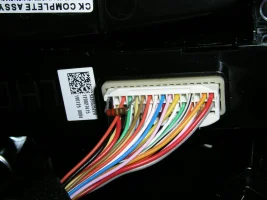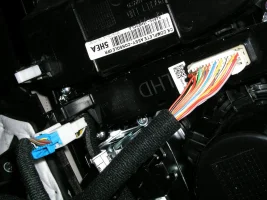There are several threads on this subject so I apologize if this method has been mentioned and I missed it. Anyway, I've hated this 'feature' since I bought the car. I did this mod not long after I purchased the car so it has been in there for several months and around 11,000 miles with no issues. I did this on my 2019 GT2 but I have to believe the same mod will work with most, if not all, Stingers.
I managed to find the schematic for the switch on the console and I noted that there is a 220 ohm resistor in series with the switch. I'm guessing that the engineers might have done this so that simply shorting the connector wouldn't work (I never tried that). I happened to have a 220 ohm 1/4 watt resistor so I inserted that into the connector and, voila, the ISG function is now disabled. The attached photos show the connector and the resistor in place. As you can see the resistor is placed between the black and yellow wires (pins 28 and 32).
If you wonder why I did it this way all I can say is 1) I didn't like the idea of sticking something in the button to keep it pressed and 2) I didn't want to dismantle the switch and stick tape or something else to keep the button pressed. I know there's a module for sale that does this and some other functions but you need to cut wires in order to install it and I didn't really care for that solution. This has the advantage that the resistor is held in place by friction alone and simply removing the resistor restores the original function of the switch.
I managed to find the schematic for the switch on the console and I noted that there is a 220 ohm resistor in series with the switch. I'm guessing that the engineers might have done this so that simply shorting the connector wouldn't work (I never tried that). I happened to have a 220 ohm 1/4 watt resistor so I inserted that into the connector and, voila, the ISG function is now disabled. The attached photos show the connector and the resistor in place. As you can see the resistor is placed between the black and yellow wires (pins 28 and 32).
If you wonder why I did it this way all I can say is 1) I didn't like the idea of sticking something in the button to keep it pressed and 2) I didn't want to dismantle the switch and stick tape or something else to keep the button pressed. I know there's a module for sale that does this and some other functions but you need to cut wires in order to install it and I didn't really care for that solution. This has the advantage that the resistor is held in place by friction alone and simply removing the resistor restores the original function of the switch.
Attachments
Last edited:





